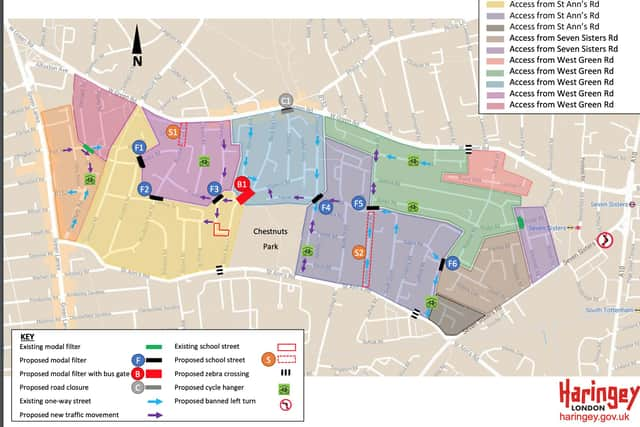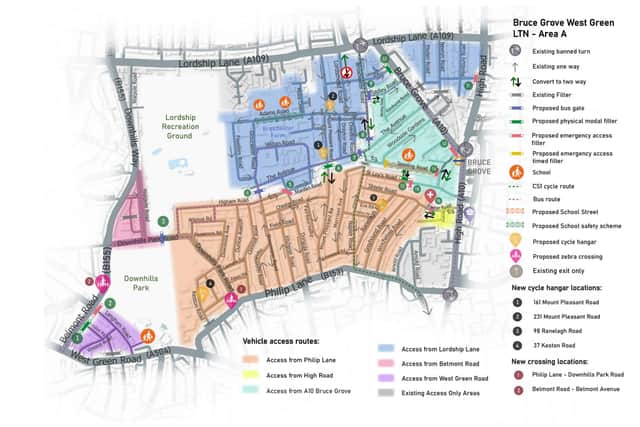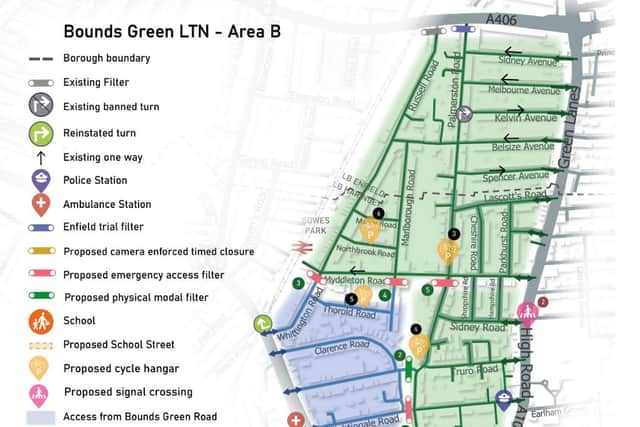Low-traffic neighbourhoods: Haringey Council likely to bring in three LTNs
and live on Freeview channel 276
Haringey Council is likely to bring in three low-traffic neighbourhoods after officers recommended introducing the no-car zones in the north London borough.
The proposed filtered areas are for residential areas in Bruce Grove and West Green, St Ann’s - between Green Lanes and Seven Sisters - and Bounds Green.
Advertisement
Hide AdAdvertisement
Hide AdThis will block off cars and vans to encourage more people to make short journeys by walking and cycling.
It will be up to Haringey Council’s Cabinet to sign off the proposals, however given it has officer recommendation it is highly likely the LTNs will be approved.


The three low-traffic neighbourhoods will allow exemptions for blue badge holders, special educational needs transport and essential services for those with disabilities.
Some of the filters will be camera operated so - as well as exempt vehicles - emergency services can pass through easily.
Advertisement
Hide AdAdvertisement
Hide AdIn Bruce Grove, there will be barriers along the west side of Tottenham High Road and in residential streets between Lordship Lane and Philip Lane.


The council is also proposing to install several filters to the east of Turnpike Lane Tube station.
In Bounds Green, there will be car barriers to the west of Green Lanes, and also blocking off Bounds Green Road to the south, by the Tube station.
In St Ann’s, there will be several filters in residential streets between Seven Sisters and Green Lanes.


Advertisement
Hide AdAdvertisement
Hide AdThe LTNs will be installed on a trial basis for 18 months, before potentially becoming permanent.
The council report says low-traffic neighbourhoods are needed to:
- Reduce pollution which can affect lung function and breathing, worsening respiratory diseases including asthma in children and chronic obstructive pulmonary disease in adults.
- Improve health outcomes related to inactivity.
- Reduce motor traffic collisions.
- Reduce carbon emissions in our attempt to avoid catastrophic climate change.
- Reclaim neighbourhood streets for pedestrians and communities and to make safe welcoming, inclusive spaces for all residents.
Cycling campaigners hailed the installation of the LTNs - which will be the first in Haringey.
Niamh McIntyre commented: “So a full *18 months* after Streetspace funding was first announced, and after some LTNs have been in place for over a year, Haringey will hopefully finally implement its first LTNs, pending next week’s council meeting.
Advertisement
Hide AdAdvertisement
Hide Ad“Pleased to see the council is proposing the full-fat option which should make the currently-horrendous Black Boy Lane a lot better for walking/cycling/wheeling.”
While Jon Stone said: “This could be big news for cycling in north London.
“Haringey council officers recommend all three proposed LTNs go ahead in Bruce Grove, St Ann’s and Bounds Green, with exemptions only for blue badge holders.
“Haringey has been criticised for being slow on active travel in the past, but these would make a big difference - massively improving routes up to Enfield, towards Green Lanes, towards Hackney and central London, between Tottenham and Wood Green.”
Advertisement
Hide AdAdvertisement
Hide AdLow-traffic neighbourhoods - which prioritise pedestrians and cyclists over cars - were rolled out in large numbers during the coronavirus pandemic, to allow people to travel safely away from public transport.
Supporters say they are essential to tackling pollution and climate change, by encouraging Londoners to take more sustainable transport.
Advertisement
Hide AdAdvertisement
Hide AdHaringey Council’s cabinet will make a decision on December 7.
